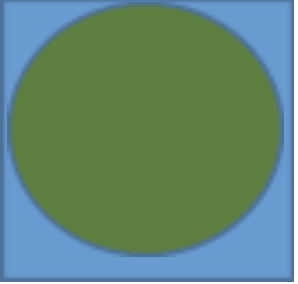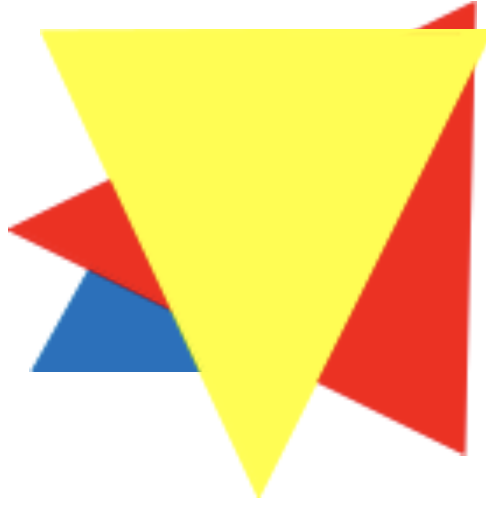Metal Insets
Materials:
Two sloping stands with a narrow edge at the bottom..
On each stand rest five metal frames with blue insets. In the center of each inset is a small knob. The 10 insets are: square, triangle, circle, ellipse, rectangle, oval, trapezoid, pentagon, curvilinear triangle and quatrefoil. They are the same size as the corresponding figures in the geometry cabinet.
Underlays 14 cm x 14 cm in a box
Paper 14 cm x 14 cm in a box
Pencil holders or trays
Soft, colored pencils in holders, one holder for each color
Purposes:
Development of mastery of the hand in using and controlling a writing instrument
Preparation of the hand for writing
To develop a sense of geometric and artistic design
Age: 4 and up
Preparation:
The child has traced the Geometry Cabinet insets
The child has worked with the Touch Tablets
Parallel Exercise: The child is writing numbers and words with chalk on the chalkboard
Presentation #1: Figure with Vertical Lines
Invite the child for a lesson on Metal Insets and load the tray with an underlay, two pieces of paper, three different colored pencils, and a curvilinear frame with a matching inset.
The Guide sits on a stool in the child’s place and the child sits on the chair to the left of the guide.
Unload the tray.
Take one paper and place it on the underlay perfectly aligning the sides.
Place the frame on the paper perfectly aligning the sides.
With the left hand, select a pencil and transfer to the right showing the child your pencil grip.
The left hand steadies the frame while the right traces the aperture, or inside, of the frame. Trace clockwise with the pencil vertical.
Replace the frame on the inset and then place the inset exactly on the drawn outline. Emphasize the care you are taking lining it up.
Select a different pencil in the same manner as the first.
The left fingers hold the knob of the inset while the right traces.
Replace the inset into the frame.
Select the last pencil and make vertical lines top to bottom moving left to right. The lines touch the top and bottom of the shape while the hand floats above the paper.
Write your name on the paper.
Place a fresh piece of paper onto the underlay and invite the child. Explain they may also turn their paper over to make more than one.
Take your paper, fade, and observe.
The child may continue but may take only one paper at a time.
Presentation #2: A Figure with a Continuous Vertical Line
Invite the child and bring materials as in the previous lesson.
Sit as before with the Guide in the child's place and unload the tray.
Trace frame and inset with the same process as before.
For the third color: start at the top of the shape and make serpentine, snake, lines top to bottom left to right.
Write your name, replace it with new paper, and invite.
Take your paper, fade, and observe
Note: On another day present again making the lines closer and closer together so eventually they are so close that there is no white space between them.
Control of Error: Any stray lines.
Points of Interest:
Modeling how to pick up and hold the pencil.
Working to make each outline free of wobbles and breaks.
To make an equal amount of space between the line drawn for the frame and for the inset.
All vertical lines do not cross the innermost outline.
Following Exercises: Insets only because it is more challenging
Two Insets and Two Colors: Choose 2 insets and 2 colors. Trace one, decide on placement for second, and trace. Fill in one entire shape with serpentine lines. Use the other color to fill in the remaining spaces.
Three Insets and Three Colors: Repeat as above but with three colors.
One Inset in Two Positions: 1 inset and 2 colors. Trace and then reorient the inset and trace with the other color. Completely fill in one shape with one color and fill in the remaining spaces with the other color.
One Inset in Three Positions: 1 inset, 3 colors. Repeat as above only tracing the inset in three positions.
Geometric Design: Free exploration on a ½ sheet of paper. Use any of the shapes and colors you want.
Shading: 1 shape, 1 pencil: Trace around the inset. Shade in the shape light to dark or light to dark. Model the lightness and firmness (pressure) to get the desired color.
*Variation of Shading: Monochromatic Design: 1 shape, 1 pencil, and ½ sheet of paper. Trace the shape in several places overlapping. Fill in using light, medium and heavy pressure.
Pedagogical Notes:
We do not leave our examples to the child because we don’t want the child to compare. We want the work to be their original work
Some children may benefit by starting only tracing the frame and inset without filling it in to build confidence.
Metal insets change the structure of the brain. If you can make straight up and down lines, you can make any line.
The child may change the colors they have selected by taking the pencil holder back to the shelf and exchanging it for the ones they want. Only three pencils at a time.
The metal inset color pencils are only for metal insets. Only keep as many of each pencil as you have a tray for.
The children are also exploring the relationship between shapes.
The children may not create pictures with this work. If they draw pictures, inform them that this work is only for metal insets and that they may take drawing paper and drawing pencils if that is an activity they would like to do.
Using hand sharpeners is nice to keep the noise down.
TIP! Have a ream of paper cut at an office supply such as Staples or Kinkos. Ask them to cut lengthwise at 5 ½” and then cut that strip in half. The leftover long strip gets cut in half lengthwise and you have strips for language labels/exercises.







